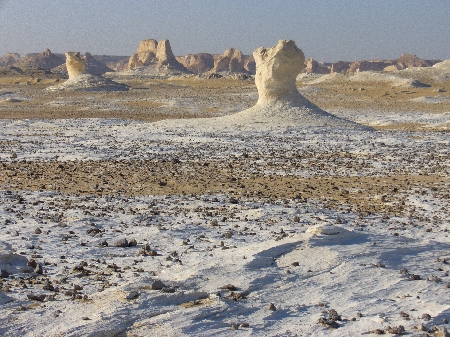
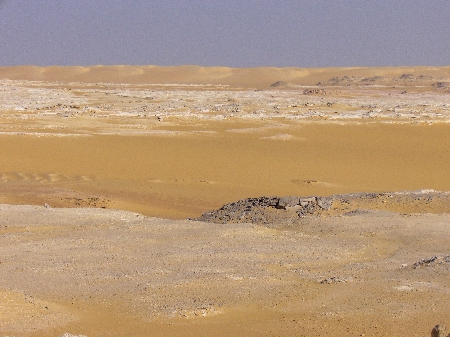
1. Desert sandy and rocky plains.
Extreme habitat, mostly without any vegetation. Single xerophyllous plant survive only in some rock crevices.
Characteristic species: Bassia eriophora, Haloxylon salicornium, Zygophyllum album.
 |
 |
2. Desert wadis.
Little less extreme habitat occurring within desert plains. Old drainage channels that formed during wetter period of the past (mostly Early Holocene). After every rain, underground water collects in the old channels and makes environment less harsh for the plant growth.
Characteristic species: Acacia tortilis, Bassia eriophora, Haloxylon salicornium, Pulicaria undulata, Zygophyllum album.
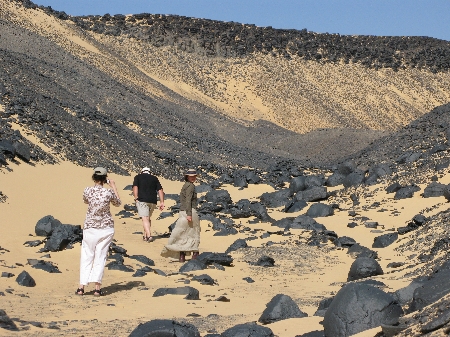 |
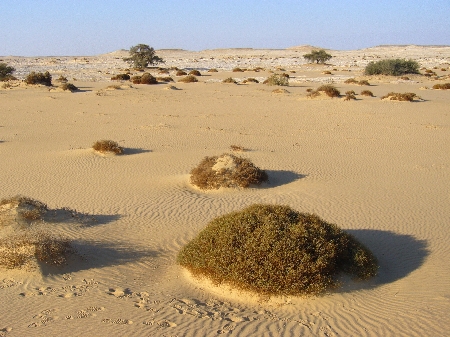 |
3. Zone of the old settlement with vegetation relics.
Habitat usually occurring in the transition from desert to agricultural land. Mostly shrubby vegetation forming agools – vegetation mounds. This vegetation stabilises sand that sometimes forms sand dunes. In Bahariya Oasis, numerous remnants of Roman Age and Middle Ages settlement are present in this zone. Most likely, surviving shrubs are the relics of past vegetation that has been present in irrigated agricultural land many centuries ago.
Characteristic species: Alhagi graecorum, Calligonum polygonoides, Desmostachya bipinata, Stipagrostis scoparia, Tamarix amplexicaulis, Tamarix aphylla, Tamarix nilotica.
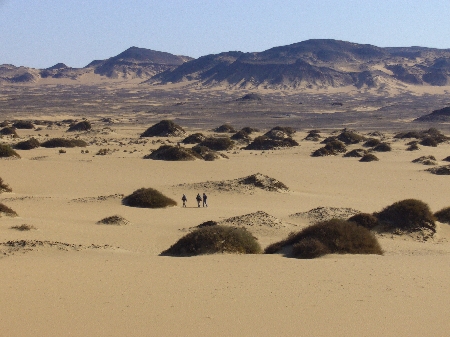 |
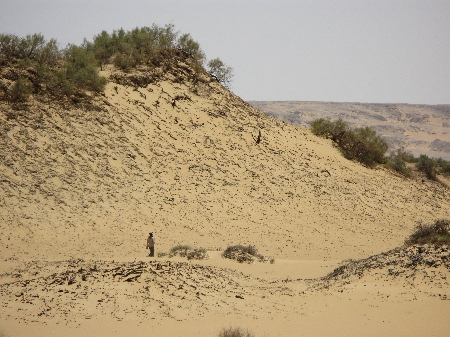 |
4. Salt marches.
Soluble salts are omnipresent in the desert environment. Sometimes they reach extreme concentrations, like along the shores of shallow water basins, where water from irrigation collects. In such conditions, despite they grow in wetlands, plants suffer lack of water due to extreme osmotic potential of the soil.
Characteristic species: Aleuropus lagopoides, Centaurium tenuiflorum, Spergularia media, Frankenia hirsuta, Phragmites australis (in nanic form).
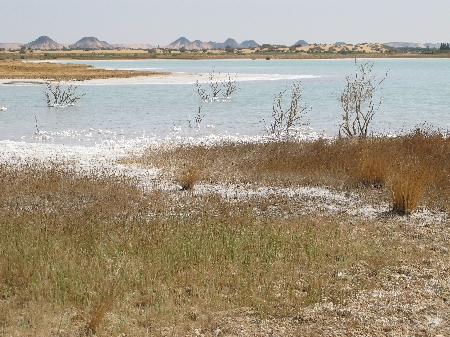 |
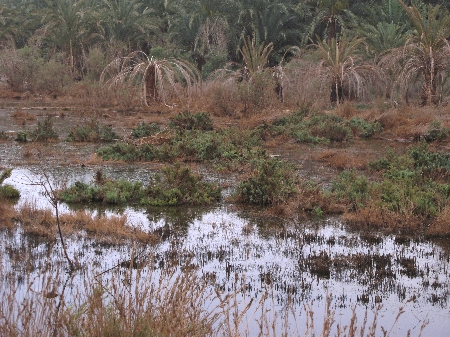 |
5. Highly saline agricultural land.
Due to irrigation using mineral-rich artesian water and due to high evaporation, agricultural lands (both fields and pastures) tend to become highly saline. Finally, they can be even lost this way.
Characteristic species: Spergularia media, Aleuropus lagopoides, Frankenia hirsuta, Juncus acutus, Juncus rigidus, Phragmites australis (in nanic form), Salsola tetragona, Sarcocornia fruticosa.
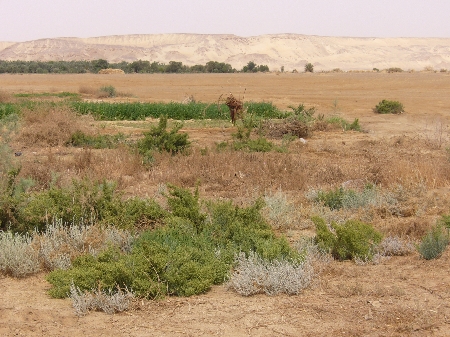 |
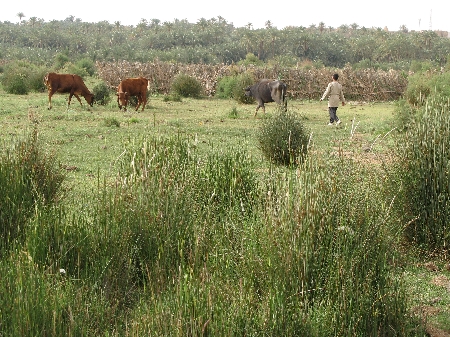 |
6. Spring edges and canal banks.
Most of the natural springs in the Bahariya Oasis gave only little amount of water. Since very old times, numerous wells were dug to supply water to people and animals and to irrigate agricultural land. Today, the water table in the underground reservoir has dropped significantly down due to intensive exploitation. Now, wells several hundreds of meters deep must be drilled using heavy machinery.
Characteristic species: Cynodon dactylon, Cyperus laevigatus, Eleocharis palustris, Fimbristylis sieberiana, Lotus glaber, Mentha longifolia, Oxalis corniculata, Panicum coloratum, Paspalidium geminatum, Phragmites australis, Plantago major, Polypogon monspeliensis, Pseudognaphalium luteoalbum, Pycreus polystachyos, Rumex dentatus, Sonchus maritimus.
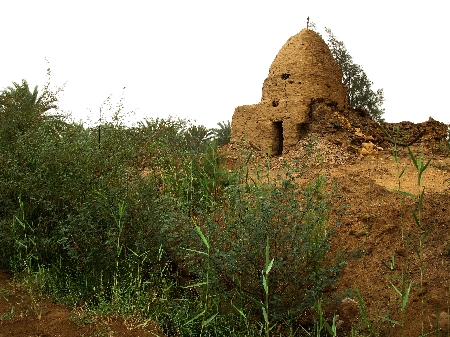 |
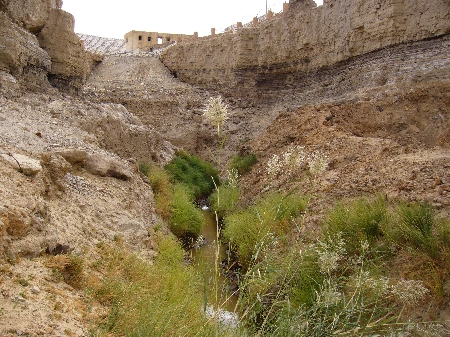 |
7. Artificial water bodies.
Before coming to the fields and orchards, water from wells often collects in small and shallow artificial water reservoirs. This is the only stagnant fresh water occurring in the Oasis.
Characteristic species: Bolboschoenus glaucus, Phragmites australis, Typha domingensis, Utricularia gibba, Utricularia inflexa, Zannichellia palustris.
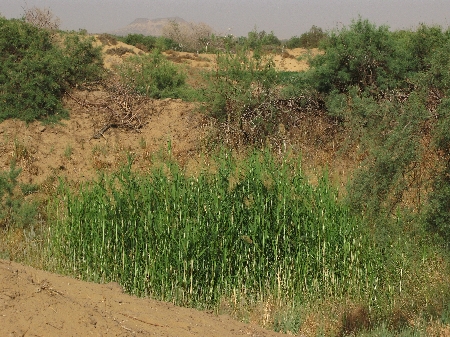 |
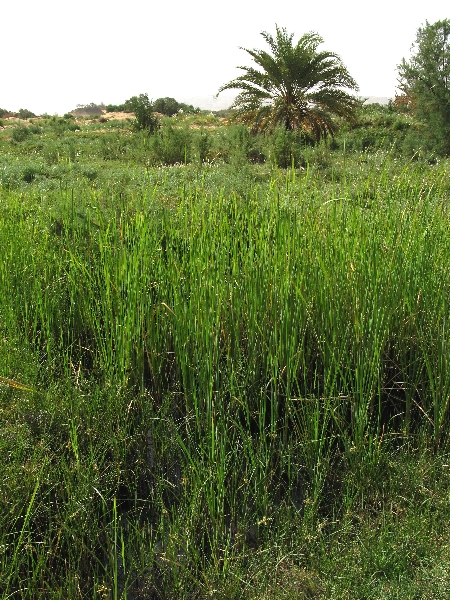 |
8. Cereal fields.
Besides dates, cereals are the most traditional agricultural product - namely wheat (Triticum), dakhn (Pennisetum glaucum) and dura (Sorghum bicolor). In the last decades, also maize is locally cultivated. As herbicides are unknown stuff among locals, weeds are numerous in the fields. This is especially true for omnipresent weedy oat - Avena barbata.
Characteristic species: Amaranthus graecizans, Amaranthus viridis, Ammi majus, Avena barbata, Lolium temulentum, Melilotus messanensis, Melilotus segetalis, Plantago arenaria.
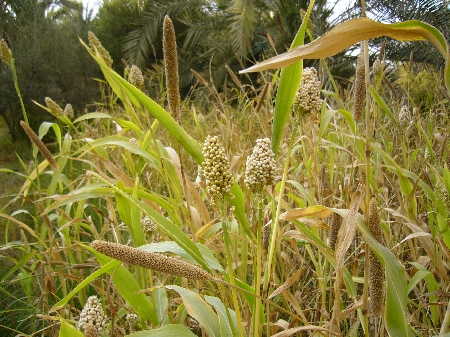 |
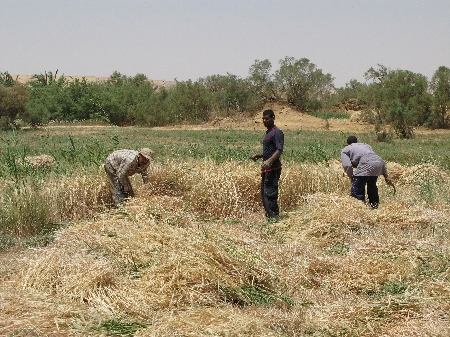 |
9. Other cultivated ground.
As local families are the only owner of the land, agricultural ground is finely patterned. Many kinds of crop and herbs are cultivated in the fields and garden plots. Widely cultivated is also fodder for domestic animals – namely alfalfa (Medicago sativa) and clover (Trifolium alexandrinum). Fallow land is usually grazed. Variety of individual management practices induces high diversity of weed flora.
Characteristic species: Ambrosia maritima, Centaurea calcitrapa, Cichorium endivia, Convolvulus arvensis, Emex spinosa, Euphorbia helioscopia, Euphorbia peplus, Fumaria densiflora, Chenopodium murale, Imperata cylindrica, Lathyrus hirsutus, Malva parviflora, Phalaris minor, Portulaca oleracea, Solanum nigrum, Solanum villosum, Sonchus maritimus, Sonchus oleraceus, Urospermum picroides, Vicia sativa.
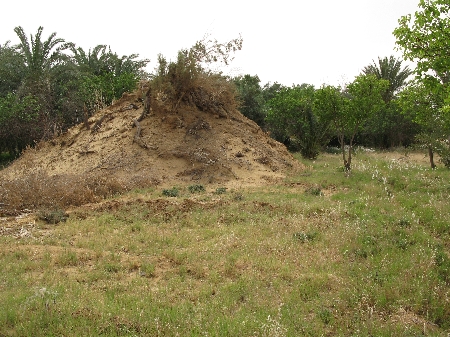 |
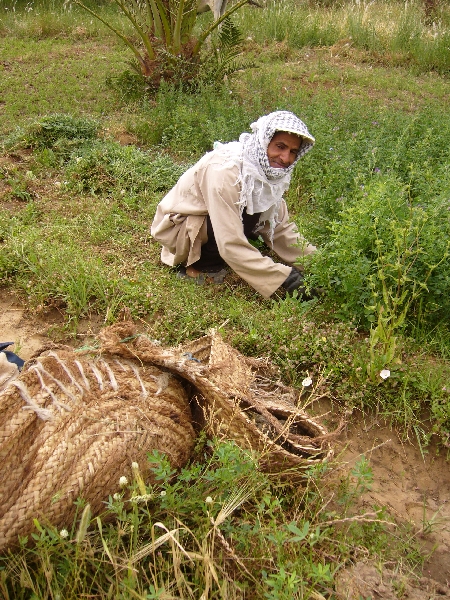 |
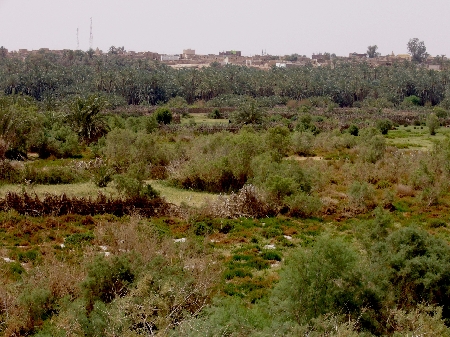 |
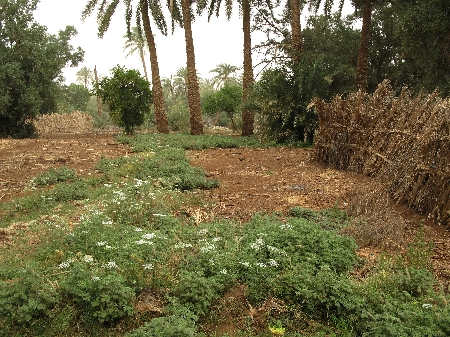 |
10. Orchards.
Economy of Bahariya Oasis is largely based on the production of excellent-quality dates. Date palm (Phoenix dactilifera) orchards are most striking feature of the inhabited parts of the Oasis when viewing from the distance. Besides date palm, also olive (Olea europaea) and apricot (Armeniaca vulgaris) are widely cultivated. Other fruit trees are grown as well (like figs, pomegranate, guava, mango), but only as single trees or in the shade of date palms. Weeds growing in the orchards are all species tolerant to permanent shade.
Characteristic species: Ambrosia maritima, Anagalis arvensis, Bidens pilosa, Calendula arvensis, Centaurea calcitrapa, Centaurium tenuiflorum, Cichorium endivia, Cyperus rotundus, Plantago lagopus, Pluchea dioscoridis, Trifolium resupinatum.
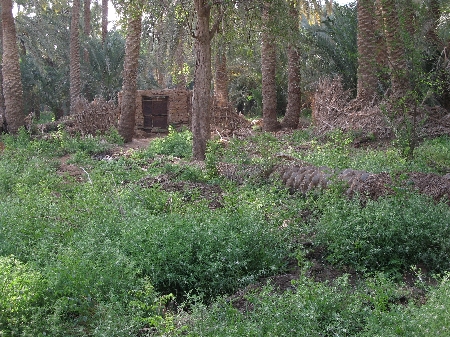 |
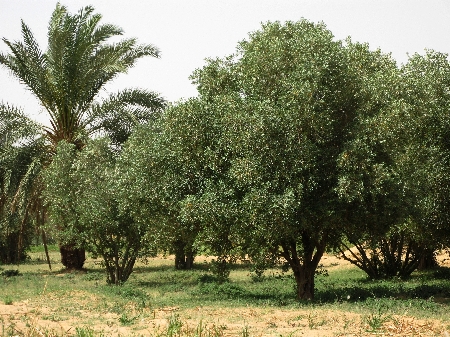 |
11. Town and the villages – intravillan.
Being very dry and often full of toxic substances, narrow streets and yards of the town Bawiti and the villages are often without any vegetation. Some weeds are only present at localized watered places like ornamental patches and decorative lawns lining some roads.
Characteristic species: Conyza bonariensis, Cynodon dactylon, Euphorbia hirta, Lolium perene, Polypogon monspeliensis.
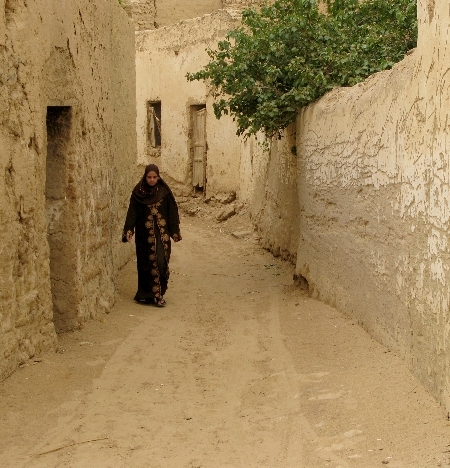 |
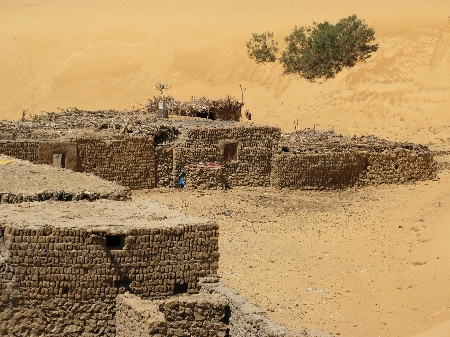 |
12. Abandoned agricultural land and disturbed ground.
Management practices within the desert oasis are sometimes unsystematic and random, especially in the uneasy transition from cultural land to desert. In such places, tollerant rhizomatous species often grow.
Characteristic species: Ambrosia maritima, Aleuropus lagopoides, Alhagi graecorum, Desmostachya bipinata, Tamarix aphylla, Tamarix nilotica.
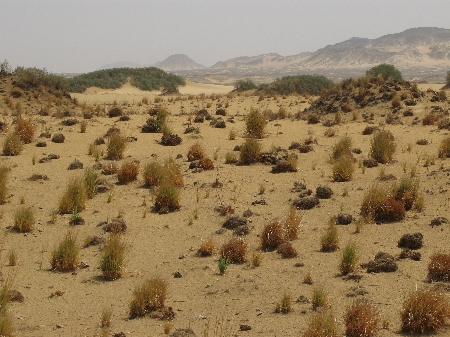 |
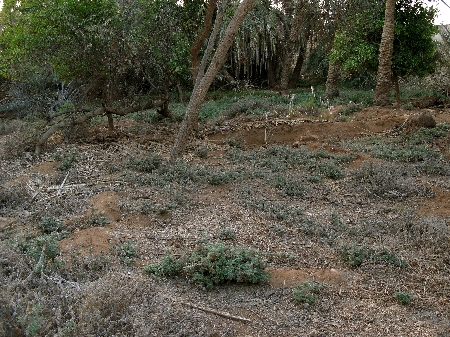 |

Satellite image of the section of El-Hayez oasis. Longer axis about 3 km. Numbers refer to individual habitats listed above.